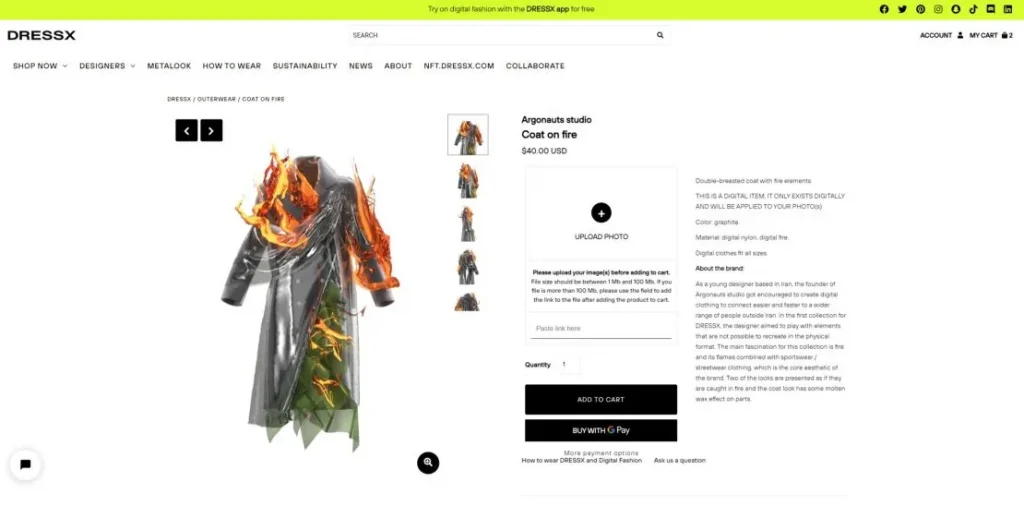- XR/AR/VR technologies enable real-time 3D simulations, transforming fashion design by allowing designers to tweak clothing details without physical sampling, enhancing efficiency, and fostering global collaboration.
- Augmented reality-powered virtual fitting rooms, like Gap’s, improve customer convenience, boost sales conversion rates, and reduce return rates, offering a personalized and enjoyable online shopping experience.
- The fashion industry is on the verge of complete digitization, optimizing production processes and enhancing sustainability. This shift allows for on-demand production, reducing waste and creating a more eco-friendly fashion landscape.
Firing up imagination: A novel age of virtual prototyping
Fashion design is currently basking in the glow of a digital revolution, and XR/AR/VR technologies are acting as the torchbearers of unprecedented creative inspiration. Virtual prototyping empowers designers to tweak clothing contours, fabrics, and patterns in real-time 3D simulations, sidestepping the costly realm of physical sampling and significantly amplifying design efficiency. This technological marvel not only compresses design cycles but also provides designers with a vast expanse for experimentation, all without squandering copious raw materials.
Moreover, this newfound flexibility allows designers to collaborate seamlessly with geographically dispersed teams. The digital thread woven through the design process not only fosters creativity but also enhances communication, breaking down traditional barriers. As these digital designs become the cornerstone of the supply chain, the ripple effects of streamlined production are felt throughout the industry. The era of digital design is here, heralding a more sustainable and efficient future.
Digital metamorphosis: The fashion industry’s virtual evolution
Brands are now embracing the digital zeitgeist, with digitized prototyping and sampling becoming integral to the narrative of innovation. According to Bennett Heyn, “I’ve witnessed successful cases, including brands digitizing prototyping and sampling processes to truncate delivery cycles, and crafting virtual showrooms and fitting rooms to extend the reach of customer access and engagement.” These success stories not only fortify brand competitiveness in the cutthroat market but also provide customers with immersive digital fashion experiences.
Take, for instance, the digital-only brand DressX, which is not merely adapting to this shift but pioneering it. By selling AR garments tailored for virtual events and spaces, DressX offers a unique experience to global customers who can revel in the delightful process of trying on and purchasing one-of-a-kind designs in the digital realm. This marks a paradigm shift in how consumers interact with fashion, transcending the physical constraints of traditional shopping.

Virtual fitting Rooms: Elevating engagement and augmenting shopping experiences
The advent of virtual fitting rooms has not only carved a niche in the digital fashion landscape but has also bestowed unparalleled shopping convenience upon customers. Gap’s virtual dressing room, fueled by augmented reality technology, empowers customers to “try on” items within a digital environment.
This technology not only serves as a catalyst for increased sales conversion rates but also mitigates return rates stemming from size mismatches.
Bennett Heyn
The digital augmentation doesn’t merely reduce shopping uncertainties but transforms the entire shopping experience into a seamless, enjoyable affair.
Beyond the immediate impact on sales and returns, virtual fitting rooms represent a seismic shift in how consumers perceive and engage with fashion. The integration of AR technology in the shopping experience reduces the guesswork associated with online shopping, providing a more personalized and confidence-boosting encounter. The ripple effects extend to brand loyalty, as customers find themselves more connected to brands that offer a digital shopping journey tailored to their needs.
Paris Fashion Week has embraced innovation with the introduction of an AR (Augmented Reality) kiosk, allowing visitors to virtually “try on” designer clothes. This unique blend of digital technology and fashion enables users to select different designer outfits and experience the virtual sensation of wearing them. The interactive nature of this innovation provides an immersive fashion experience, showcasing cuts, patterns, and fabrics in virtual reality. The primary objective is to reduce customer shopping uncertainty through digital try-ons, streamlining the traditional fitting process. This not only serves as a technological showcase but signifies the perfect fusion of fashion and technology, adding a futuristic dimension to Paris Fashion Week. It reflects the fashion industry’s commitment to innovation, driving the evolution of the fashion retail experience and opening up new possibilities for future exhibitions and shopping activities in the digital era, where AR technology plays a pivotal role.

Also read: Paris fashion week showcases AR kiosk at allow visitors to “Try” designer clothes
Pop quiz
What benefits does virtual prototyping bring to the fashion industry, according to Bennett Heyn?
A. Increased physical sampling costs
B. Limited design experimentation
C.Real-time 3D simulations and enhanced design efficiency
D. Geographically isolated collaboration
The answer is at the bottom of this article.
Virtual fashion shows: Unraveling new avenues for brand influence
With the meteoric rise of virtual fashion shows, the interaction between brands and audiences has reached new depths. Utilizing technologies like Oculus Quest, remote audiences can partake in a front-row or backstage experience within a social, multi-user environment, offering designers real-time insights into audience reactions. This level of interactivity not only broadens brand reach but also enriches the viewer’s brand experience.
The immersive nature of virtual fashion shows goes beyond the visual spectacle of traditional runway events. It transforms the audience from passive spectators to active participants, fostering a deeper connection with the showcased designs. Brands, by embracing virtual shows, not only increase their digital footprint but also gain invaluable insights into consumer preferences and reactions. This dynamic interaction sets the stage for a more engaging and participatory future for fashion presentations.
Innovative marketing: Shaping the future landscape of digital fashion
Digital fashion isn’t confined to the realms of design and display; it is profoundly influencing fashion marketing. Innovative marketing methodologies encompass showcasing ‘wearable’ garments in virtual spaces and integrating interactive AR features into advertisements across print, digital, and public platforms. These innovations not only amplify brand exposure but also attract more attention and facilitate data collection. Brands engaging with customers on digital platforms are no longer part of a unidirectional broadcast but are actively cultivating more intimate relationships.
Innovative marketing in the digital realm transcends traditional boundaries. The concept of “wearable” virtual garments not only captures attention but also transforms passive viewers into active participants. The integration of AR features in advertisements bridges the gap between the digital and physical worlds, providing consumers with an interactive and memorable experience. This shift in marketing strategies not only boosts brand visibility but also lays the foundation for a more dynamic and immersive consumer-brand relationship.
Also read: Wearable & powered by GPT-4, the AI Pin will soon drop
Future prospects: The complete digitization of the fashion value chain
We are on the cusp of witnessing the complete digitization of the fashion value chain, with brands existing entirely virtually, and consumers primarily interacting through immersive technologies. This future foresight seamlessly integrates digital technology into every facet of the fashion industry. The era of digital production is dawning, heralding more flexible production processes, and maximizing sustainability and trend responsiveness. This will inevitably give rise to more intelligent manufacturing processes grounded in the troves of digital twin data, optimizing production benefits to the fullest.
The complete digitization of the fashion value chain represents not only a technological leap but a paradigm shift in how the industry operates. From on-demand production to just-in-time manufacturing, the digitized value chain aligns seamlessly with sustainability goals. Brands can optimize resources, reduce waste, and respond swiftly to evolving trends, creating a more resilient and eco-friendly fashion ecosystem. As the industry progresses toward this digital future, the integration of technologies like XR/AR/VR will be the driving force behind a more connected, efficient, and sustainable fashion landscape.
Navigating the innovative landscape of digital fashion
Bennett Heyn mentions, “I’ve come across some remarkable innovations, such as showcasing digital seasonal collections via VR and co-creating bespoke garments with customers through AR visualizations.” In this digital fashion wave, some brands are even crafting virtual clothing, transforming them into digital artworks traded on fashion NFT marketplaces, heralding the convergence of fashion and digital art. This trend not only enhances brand allure in the market but also opens up novel frontiers for fashion creativity.
The marriage of fashion and digital art through NFT marketplaces signifies a broader cultural shift. It’s not merely about garments but about owning a piece of digital creativity, blurring the lines between fashion and art. Brands that embrace this intersection are not only staying at the forefront of innovation but are actively contributing to the evolution of how we perceive and consume fashion. The future promises not only more sustainable and efficient practices but also a more diverse, creative, and inclusive fashion landscape.
Potential challenges: Navigating the rapids of digital fashion
Nevertheless, digital fashion is not without its potential challenges. Issues such as inaccessibility among disadvantaged demographics, the inhibition of personal connections through digitization, and concerns about privacy regarding data capture need to be earnestly addressed. These challenges require thoughtful consideration, especially in an era where digital wear is gradually becoming the norm.
As digital fashion becomes more prevalent, the industry must address the social and ethical implications of this transformative shift. Accessibility should not be a luxury but a fundamental aspect of digital fashion, ensuring that innovative experiences are inclusive and available to diverse demographics. Additionally, the industry needs to navigate the delicate balance between digitization and human connection, preserving the personal touch that defines the fashion experience. Privacy concerns demand robust frameworks to protect consumer data, fostering trust in an increasingly digital landscape.
Closing thoughts: The harmonious fusion of fashion and digital
The fusion of fashion and XR/AR/VR technologies brings forth a cornucopia of creativity, responsiveness, sustainability, and accessibility for both the fashion industry and consumers. Augmented reality shopping eradicates geographical constraints and liberates many communities from the limitations imposed by physical stores. The presentation of virtual fashion further diminishes restrictions based on size, ability, and age, allowing everyone to fully immerse themselves in the latest design innovations. This new era of digital fashion has dawned, not only transforming the visage of fashion but also promising a future that is more diverse, innovative, and sustainable.The journey continues, and as the digital tapestry of fashion unfolds, it paints a canvas of endless possibilities. The convergence of fashion and technology is not merely a fleeting trend but a transformative force reshaping the very essence of an industry deeply rooted in self-expression and creativity. The next chapters in this digital narrative will undoubtedly unveil even more exciting possibilities, pushing the boundaries of what we perceive as fashion and paving the way for a future where creativity knows no bounds.
The answer of the pop quiz is C

